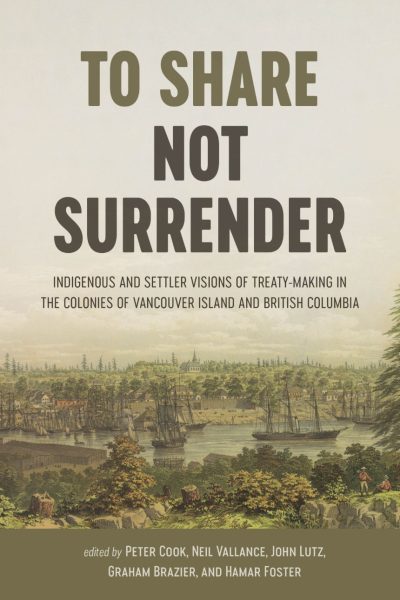
To Share, Not Surrender: Indigenous and Settler Visions of Treaty Making in the Colonies of Vancouver Island and British Columbia
Review By Alan Hanna
July 20, 2023
BC Studies no. 218 Summer 2023 | p. 129-130
Many British Columbians may know that Canada is a party to several treaties with First Nations across the country. Fewer still would know that the province of British Columbia exists on Indigenous peoples’ lands largely devoid of treaties with the Crown. As a legal mechanism for one nation to share the land and resources with another, treaties, many scholars argue, are the basis for Canada’s legitimacy on Indigenous lands. The edited collection of essays, To Share Not Surrender: Indigenous and Settler Visions of Treaty Making in the Colonies of Vancouver Island and British Columbia (Peter Cook, Neil Vallance, John Sutton Lutz, Graham Brazier, and Hamar Foster, eds.) offer an in-depth review and analysis of the history of treaty-making in the nascent colony of Vancouver Island and the 14 Fort Victoria Treaties James Douglas entered into with local First Nations between 1850 and 1854.
As a reader living on Vancouver Island, the essays provided an uncomfortable connection to this place and the people who have so generously welcomed me on their land. The essays cover a range of topics from James Douglas’ social and political background, the political relationships between London, the local government in BC, and the private interests of the Hudson’s Bay Company, to Indigenous perspectives about the meaning of the treaties. Learning about the stories associated with the colonization of BC has been both informative and disconcerting, leaving the reader to ponder the legacy of unfinished business and Indigenous land in BC. While To Share carefully winnows the colonial chaff to show attitudes, politics, and aspirations of colonial officials such as Douglas, it also makes space for Indigenous voices from within a scant historical record and the lived collective memory of Indigenous people.
Upon reading, I realized that whatever documentary record is still in existence, likely has been uncovered and analysed over the decades (e.g. Paul Tennant, Robin Fisher, Cole Harris), at least since Wilson Duff published about “these untidy and almost unknown little documents” (187) in BC Studies’ inaugural year, 1969. The tension in the interpretation of the treaties, whether they were transactional (i.e. simple land conveyances) or treaties was decided in favour of the latter in 1965 when the Supreme Court of Canada upheld the BC Court of Appeal decision in R v White and Bob. The authors instead consider other questions such as why treaty-making ended so quickly after it began, and about Douglas’ reasons for pursuing treaties in the first place. I was surprised to learn that the local government, government critics, settlers, and the media of Douglas’ era wanted the treaty-process to continue. According to one author, the answer to why treaty-making ended in 1854 is both “simple and complex,” primarily the result of political wrangling between the Colonial Office in England, the Legislative Assembly of BC, and the HBC (234). Some authors looked at evidence to understand the treaties from the First Nations parties’ perspectives, revealing another distinction regarding the documentary record. The settler colonial interpretation is gleaned from the patchwork historical record left behind by officials and participants, which is tempered by the often-racist colonial views of the mid 19th century. Only the words left behind on paper provide that perspective. In contrast, Indigenous perspectives are passed down through generations in stories Elders share with their families and communities as a living record.
Although steeped in research, there is overlap among several essays, producing some repetition. That said, in its ability to present facts and interpretations of the events surrounding the treaties, indeed, the foundation of the province as we know it today, a few redundancies do not detract from the common thread, that when Europeans arrived on these shores, Indigenous people were willing to “share, not surrender, their land and its resources” with the newcomers (149). With ample inquiry as to the reasons for treaty-making and its demise after 1854, the reader is left with the troubling question: upon what legal fiction does the legitimacy of the present government rest? To Share is a book for every British Columbian to better understand the historical, political, and relational fabric of this province, and the obligations flowing from this reality.
Publication Information
Cook, Peter et al. To Share, Not Surrender: Indigenous and Settler Visions of Treaty Making in the Colonies of Vancouver Island and British Columbia. Vancouver: University of British Columbia Press, 2021. 330 pp. $37.95 paper.
